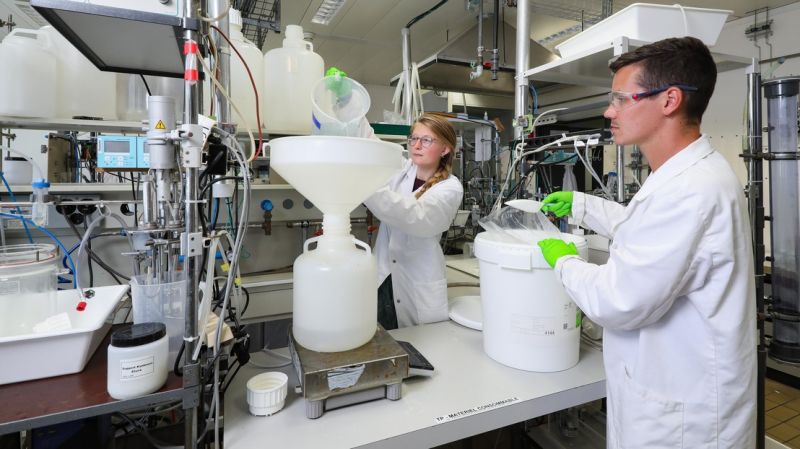A New Technique to Concentrate a Fertilizer Produced from Wastewater
Published on by Water Network Research, Official research team of The Water Network in Technology
Two EPFL Master’s in Environmental Engineering students have developed a novel method for recovering nitrogen from wastewater. For their semester project, they adapted a system typically used to concentrate fruit juice and tested it out at the Yverdon-les-Bains wastewater treatment plant in Vaud.
By Sandrine Perroud, EPFL

Océane Hames and Lucas Ott in EPFL’s Environmental Chemistry Laboratory © Alain Herzog, EPFL (Image source: EPFL)
For their semester project, Océane Hames and Lucas Ott, two Master’s students in Environmental Engineering at EPFL, chose to focus on the Yverdon-les-Bains wastewater treatment plant. This plant is known as a pioneer in Switzerland because in 2016 it became the country’s first to install a stripping membrane system for nitrogen recovery. These systems work by using a polypropylene membrane to filter the nitrogen from the rest of the wastewater, after the effluent has gone through some initial processing. By stripping out the nitrogen in this way, plants can both reduce their nitrogen emissions into nearby streams and produce a high-quality liquid fertilizer. The fertilizer made at Yverdon-les-Bains has been certified by the Swiss Federal Office for Agriculture; some 140 m3 are generated each year and sold to a local farmer who spreads it on his crops, thus completing the nitrogen cycle.
But Hames and Ott wanted to make the nitrogen recovery process more efficient by increasing the fertilizer’s nitrogen concentration to above 40 g/L, as that would cut the cost of storing and transporting the fluid. Taking inspiration from the osmotic distillation technique commonly used to concentrate fruit juice, the students developed a method specifically for nitrogen that could be incorporated into existing wastewater treatment processes. They conducted lab experiments over several days to bring the nitrogen concentration close to its saturation point. They also measured the flow rate of steam through the membrane so that engineers can later size the equipment needed to implement the technology on a large scale.
Working hand in hand with industry
The students tested their new osmotic distillation method at a pilot unit provided by Membratec, a Sierre-based firm that develops membrane technology for wastewater treatment. The unit consisted of two 25 L wastewater reservoirs, pumps and two metallic cylinders containing a stripping membrane. They ran tests on the closed-loop system using a fluid with the same composition as the fertilizer supplied to the Vaud farmer.
“Osmotic distillation has the advantage of being able to concentrate fruit juice at room temperature, meaning the juice’s taste and nutritional properties remain intact,” says Hames. Ott adds: “In osmotic distillation systems, a hydrophobic porous membrane lets gas compounds like steam pass through but not liquids. The driving force is generated by a partial vapor-pressure difference between the two fluids separated by the membrane. That’s the same mechanism we used to concentrate the nitrogen in the liquid fertilizer.”
Supplementing the theory learned in class
These types of semester projects, called Design Projects, are required of all Master’s level environmental engineering students at EPFL. They are intended to give students first-hand experience with the R&D carried out in industry. “I really liked the trial-and-error aspect of the project and the opportunity to discuss our progress week by week with a Membratec engineer,” says Ott. And according to Hames: “It was nice to take a break from the classroom and spend the day running lab experiments. And it was really motivating to know that there could be a concrete application for the work we were doing.” The students’ project was supervised by Christof Holliger, a full professor at EPFL and head of the School’s Laboratory for Environmental Biotechnology (LBE).
The students weren’t the only ones to gain from the project. Christophe Bonvin, who oversaw their work at Membratec, viewed it as a win-win experience: “We really enjoyed coaching the students. It’s impressive how much students can contribute when they’re motivated and well-guided, and when the scope of their projects is clearly defined.”
Source: EPFL
Media
Taxonomy
- Fertilizers
- Wastewater Disposal
- Wastewater Use
- Reclaimed Wastewater
- Wastewater Phycoremediation
- Wastewater Treatment
- Wastewater Collection
- Solid Wastes & Wastewater Recycling
- Water Resources Management
- Fertilizer
- Nitrogen